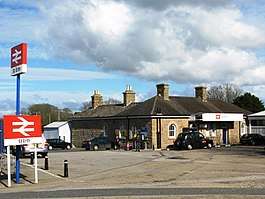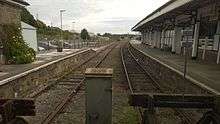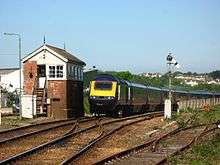St Erth railway station
| St Erth | |
|---|---|
 | |
| Location | |
| Place | St Erth |
| Local authority | Cornwall |
| Coordinates | 50°10′17″N 5°26′37″W / 50.17140°N 5.44374°WCoordinates: 50°10′17″N 5°26′37″W / 50.17140°N 5.44374°W |
| Grid reference | SW541357 |
| Operations | |
| Station code | SER |
| Managed by | Great Western Railway |
| Number of platforms | 3 |
| DfT category | E |
|
Live arrivals/departures, station information and onward connections from National Rail Enquiries | |
| Annual rail passenger usage* | |
| 2012/13 |
|
| – Interchange |
|
| 2013/14 |
|
| – Interchange |
|
| 2014/15 |
|
| – Interchange |
|
| 2015/16 |
|
| – Interchange |
|
| 2016/17 |
|
| – Interchange |
|
| History | |
| Original company | West Cornwall Railway |
| Pre-grouping | Great Western Railway |
| Post-grouping | Great Western Railway |
| 1852 | Station opened |
| 1877 | St Ives branch opened |
| Listed status | |
| Listed feature | St Erth Station |
| Listing grade | Grade II listed |
| Entry number | 1143618[1] |
| Added to list | 14 January 1988 |
| National Rail – UK railway stations | |
| * Annual estimated passenger usage based on sales of tickets in stated financial year(s) which end or originate at St Erth from Office of Rail and Road statistics. Methodology may vary year on year. | |
|
| |
St Erth railway station is a Grade II listed[1] station situated at Rose-an-Grouse in Cornwall, United Kingdom. It serves the nearby village of St Erth, which is about 0.75 miles (1.21 km) away, and is the junction for the St Ives Bay Line to St Ives. The station is 321 miles (517 km) measured from London Paddington via Bristol Temple Meads.
On an average weekday St Erth sees up to 69 trains, 26 trains to St Ives, 22 towards Penzance and 21 towards Plymouth. This makes it the busiest station in Cornwall in terms of services.
History
The station was opened by the West Cornwall Railway on 11 March 1852. At this time it was known as St Ives Road and was the railhead for that town, which lies about 4 miles (6.4 km) to the north.[2] This was an important harbour with a busy fishing trade and tin and copper mines; the new railway brought it artists and then tourists.[3] The station was a simple single platform situated on the north side of the line[4]
On 1 June 1877 a branch line was opened from here to St Ives, which was when the station was renamed 'St Erth'; a few years later the station building was reconstructed in granite[5] A second track was laid on the north side of the platform for the opening of the branch, but the main line still had only the one track. This was partly rectified in about 1894 when a loop line with its own platform was opened, but the line was only doubled eastwards to Hayle on 10 September 1899, and westwards to Marazion on 16 June 1929.[4] Beyond the St Ives branch platform was the station goods yard and sidings which served a china clay dry for a few years. It then served milk trains from the Primrose Dairy creamery, later operated by United Dairies,[6] although these were taken out of use in 1982.[7]
| Preceding station | Historical railways | Following station | ||
|---|---|---|---|---|
| Marazion | Great Western Railway Cornish Main Line |
Hayle | ||
| Terminus | Great Western Railway St Ives Branch |
Lelant | ||
Description


The station buildings are constructed of granite in an 'L' shape west and north of the St Ives bay platform. The booking office is staffed for part of the day and is located in the west-facing section which faces the station car park. The northern range incorporates staff accommodation as well as refreshment facilities which appeared in a list of the ten best station cafes published in The Guardian in 2009.[8]
Alongside this is a short siding with a loading platform, and the terminal track of the St Erth/St Ives branch line; the platform for this is number 3 and is long enough for a five-coach train. The opposite side of this is platform 2. Mainly used by trains towards Plymouth and beyond, it is also used by through trains for Penzance moving on or off the St Ives branch.[9] Because the main line is on a falling gradient towards Hayle, at the buffer stop end a few steps are needed to connect platforms 2 and 3 but at the east end they are nearly level. Standing at this end of the station the line to St Ives curves away to the left over Western Growers Crossing towards the covered way beneath the A30 road. The Cornish Main Line towards Hayle drops gently to the right with the signal box situated between the two.[9] The Down Sidings on the right of the main line are level and so are higher than the main line at the far end.
Platforms 2 and 3 have a long canopy above them to protect passengers waiting for their train. At the west end of this is a covered footbridge which links with the main westbound platform for trains to Penzance, and a large wooden shelter is provided here. A small granite building further up the platform is for staff use. As with several other stations in Cornwall, small palm trees grow on the main platforms, both of which can accommodate seven-coach trains.[9]
In 2017, a new concourse and ticket office was opened in St Erth, replacing the old ticket office which was smaller. The new building now includes toilet facilities and a waiting lounge, including a medium-sized ticket office with two windows. This process also included upgraded step-free access to the concourse and to platforms 2 & 3. A new entrance to platforms 2 & 3 near to the station cafe was also built, next to an also new private building for staff only. An improved transport interchange is under construction in 2018. [10]
Signalling

The signal box is situated at the east end of the station between the main line and the St Ives branch. It was opened on 10 September 1899 when the main line was doubled to Hayle and replaced an earlier box that dated from around the time of the opening of the St Ives branch. Semaphore signals still control movements around the station. The signal box also controls trains on the St Ives branch.[7]
Passenger volume
St Erth sees more passengers change train than any other station in Cornwall.[11]
| 2002-03 | 2004-05 | 2005-06 | 2006-07 | 2007-08 | 2008-09 | 2009-10 | 2010-11 | 2011-12 | |
|---|---|---|---|---|---|---|---|---|---|
| Entries | 35,664 | 45,570 | 44,280 | 33,472 | 33,844 | 46,719 | 37,624 | 60,385 | 101,181 |
| Exits | 35,742 | 44,971 | 44,061 | 33,532 | 34,386 | 46,719 | 37,624 | 60,385 | 101,181 |
| Interchanges | unknown | 85,652 | 87,676 | 102,930 | 115,100 | 119,106 | 130,517 | 138,551 | 179,632 |
| Total | 71,406 | 176,193 | 176,017 | 169,934 | 183,330 | 212,544 | 205,765 | 259,321 | 391,994 |
The statistics cover twelve month periods that start in April.
Services
.jpg)
St Erth is served by most Great Western Railway trains on the Cornish Main Line between Penzance and Plymouth with one train per hour in each direction. Some trains run through to or from London Paddington station, including the Night Riviera overnight sleeping car service and the Golden Hind which offers an early morning service to London and an evening return. Other fast trains are the mid-morning Cornish Riviera and the afternoon Royal Duchy. There are a limited number of CrossCountry trains (3 per day each way) providing a service to Scotland in the morning and returning in the evening.[12]
On the St Ives Bay Line all services are operated by Great Western Railway. A small number of branch line trains are extended from or to Penzance.[13]
| Preceding station | Following station | |||
|---|---|---|---|---|
| Penzance | Great Western Railway Cornish Main Line |
Hayle | ||
| CrossCountry Cornish Main Line |
||||
| Terminus | Great Western Railway St Ives Bay Line |
Lelant Saltings | ||
References
- 1 2 Historic England, "St Erth Station (1143618)", National Heritage List for England, retrieved 4 January 2017
- ↑ MacDermot, E T (1931). History of the Great Western Railway. 2 (1863-1921) (1 ed.). London: Great Western Railway.
- ↑ Bray, Lena; Bray, Donald (1992) [1981]. St Ives Heritage (Second ed.). Devoran: Landfall Publications. ISBN 1-873443-06-4.
- 1 2 Cooke, R A (1977). Track Layout Diagrams of the GWR and BR WR: Section 10, West Cornwall. Harwell: R A Cooke.
- ↑ Bennett, Alan (1990) [1988]. The Great Western Railway in West Cornwall (2 ed.). Cheltenham: Runpast Publishing. ISBN 1-870754-12-3.
- ↑ Jenkins, Stanley C (1992). "the St Ives Branch". Great Western Railway Journal. Wild Swan Publications Ltd (Cornish Special Issue): 2–34.
- 1 2 Pryer, GA. Signal Box Diagrams of the Great Western & Southern Railways, Volume 16: GWR Lines in West Cornwall. Weymouth: GA Pryer. ISBN 0-9532460-5-1.
- ↑ Wills, Dixe (2009-05-12). "Ten of the best railway cafes". Guardian. Retrieved 2009-06-30.
- 1 2 3 Jacobs, Gerald (2005). Railway Track Diagrams Book 3: Western. Bradford-on-Avon: Trackmaps. ISBN 0-9549866-1-X.
- ↑ Cornwall Council - St Erth https://www.cornwall.gov.uk/transport-and-streets/roads-highways-and-pavements/major-highway-schemes/st-erth-multi-modal-hub/
- ↑ "Station Usage". Rail Statistics. Office of Rail Regulation. Retrieved 2010-03-25.
- ↑ Table 51 & 135 National Rail timetable, May 2016
- ↑ Table 144 National Rail timetable, May 2016
External links
| Wikimedia Commons has media related to St Erth railway station. |
- Panoramic photograph of platforms at night
- Panoramic photograph of platforms in day
- Nick Stanton's Flickr Images of St Erth Station 2007